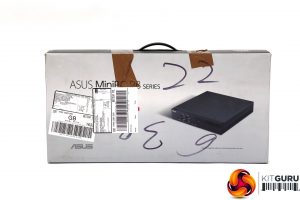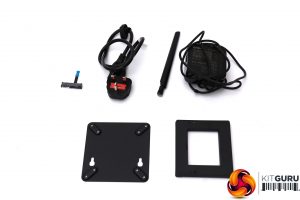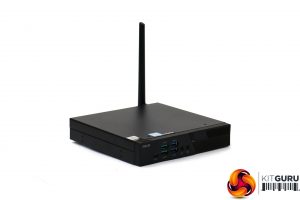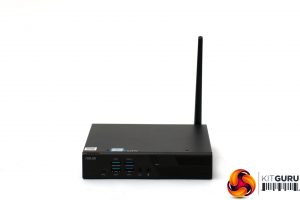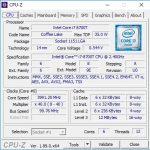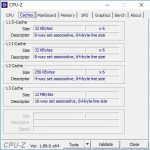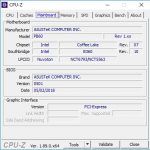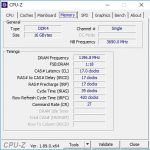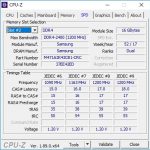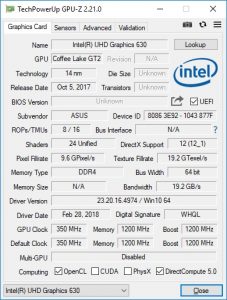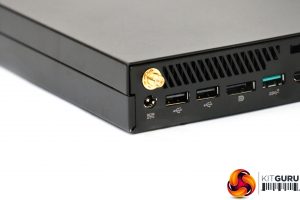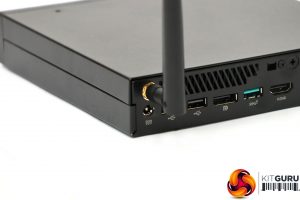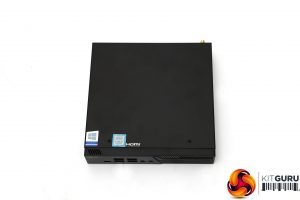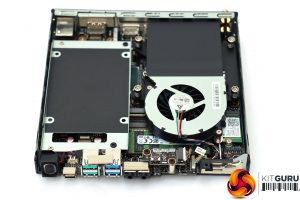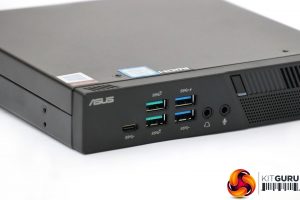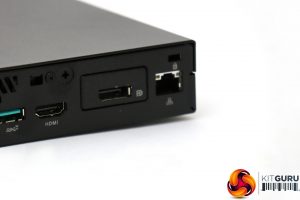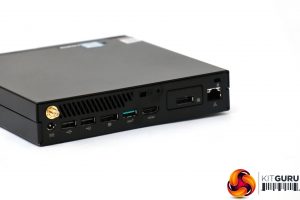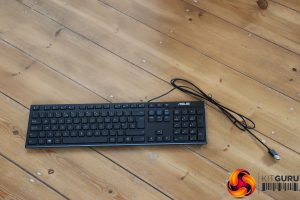The PB60 includes a standard VESA plate to enable installation behind a monitor. The power supply is external, and there's a detachable aerial for the WiFi. The small ribbon cable with a blue end is for use with the 2.5in drive bay. It routes the power and SATA signals to the storage device.
The PB60 is a fairly nondescript black square, measuring 175mm along each edge and 34.2mm high. But then it's designed to be small and unobtrusive.
There are Coffee Lake processor options across Core i3, i5, i7 and Celeron. Looking at what you can buy in the UK, these include the Core i3-8100T, Core i5-8400T and Celeron N4100. But our sample came with the top Core i7-8700T, which is a low power variant of the 8700 offering a TDP of just 35W rather than 65W. Like the regular 8700, the 8700T is a six-core CPU with Hyperthreading, but has a nominal frequency of 2.4GHz rather than the 8700's 3.2GHz.
Of course, this isn't the frequency the CPU ever really runs at. Instead, one core can run at 4GHz, up to four can run at 3.9GHz, and all six can run at 3.8GHz. So this is still a fast CPU, despite its low power consumption, although a few hundred MHz down on the regular 8700 across the board.
The PB60 incorporates two SO-DIMM slots and supports up to 32GB of DDR4 memory running at 2,400MHz. Our sample came with a single 16GB module, which means that it is running its memory in single-channel mode only. You would need to add a second module to benefit from dual-channel memory bandwidth.
Since there's no room for discrete graphics, you have to rely on whatever comes with the chosen Intel CPU. In the case of the Core i7-8700T, this is Intel UHD 630 graphics, which sports 24 execution units and a maximum frequency of 1,200MHz. It's not going to challenge even low-end discrete graphics, but does at least support DirectX 12, OpenGL 4.5 and OpenCL 2.0, so will allow software needing any of these to run.
If you want to place your PB60 where there is mains power but no wired LAN, you're in luck, because it also has 802.11ac WiFi built in with an external aerial to improve the signal. There's also Bluetooth 5 built in, which not all desktop PCs have. This could be useful for phone or wireless headset pairing.
Despite the small size of this chassis, you do get a variety of storage options. There's a M.2 slot, with 128GB and 256GB SSD options available. Our sample came with a 256GB SK Hynix SC308 drive, which should be adequate for most everyday adequate activities. However, this is only a SATA drive, not NVMe, although it's unclear whether the PB60 supports M.2 NVMe drives.
If this isn't enough capacity, there's a 2.5in bay near the front, which makes use of the adapter mentioned above to provide support for a standard 2.5in SATA drive. So you can officially add 1TB of conventional hard disk or SSD storage, although 2.5in disks of 5TB and over are now available and may also work if you need plenty of capacity.
The PB60 is positively brimming with external connectivity. The front is host to no fewer than five USB ports plus separate analog minijacks for headphones and a microphone. One of the USB ports is Type C, although ASUS lists this as version 3.1 Gen 1, which means it's limited to 5Gbits/sec. However, two of the four Type A ports are USB 3.1 Gen 2, so support 10Gbits/sec, while the other two are Gen 1.
Strangely, there are no audio connections on the rear of the chassis, although the system has a built-in speaker option which was installed in our sample. However, next to the connection for the external power supply, you get a couple of USB 2.0 ports, then full-sized DisplayPort, a single USB 3.1 Gen 2, and HDMI, with a Gigabit LAN port on the far end. In between the HDMI and LAN connections is configurable port that supports a variety of different options, including COM, VGA and DisplayPort. Our sample came with the latter.
You also get a pleasant slimline full desktop keyboard in the box, but no mouse, unless that was lost in transit somehow, because it is an optional inclusion that usually comes with the keyboard.
 KitGuru KitGuru.net – Tech News | Hardware News | Hardware Reviews | IOS | Mobile | Gaming | Graphics Cards
KitGuru KitGuru.net – Tech News | Hardware News | Hardware Reviews | IOS | Mobile | Gaming | Graphics Cards


